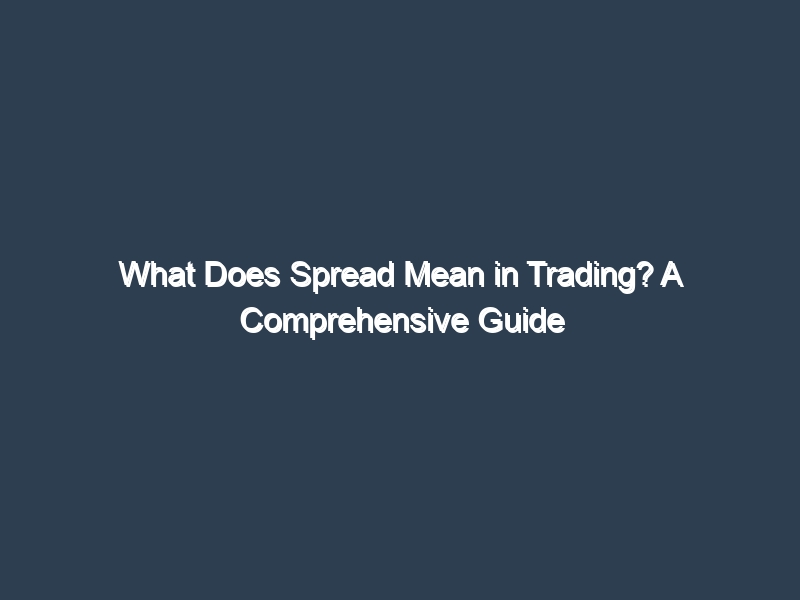
31 Jan
What Does Spread Mean in Trading? A Comprehensive Guide
In the world of trading, understanding the concept of **spread** is essential for maximizing profits and minimizing costs.
This article provides a detailed explanation of what **spread** means, examining its various types, including **fixed vs. variable spreads** and **bid-ask spreads**.
You will learn about the key factors that influence spreads, such as **market volatility** and **brokerage fees**.
Additionally, strategies for navigating spreads effectively will be discussed, enableing you to make **informed trading decisions**.
This exploration aims to clarify these fundamental elements of trading for your benefit.
Understanding Spread in Trading
Understanding the concept of spread in trading is essential for navigating the financial markets effectively, as it represents the difference between the bid price and the ask price of an asset.
This price difference, often influenced by market makers and liquidity providers, can significantly impact your trading costs, risks, and overall investment strategies.
You will encounter different types of spreads across various trading platforms, including forex trading, stock trading, and options trading, each requiring a unique approach to maximize profits while managing potential losses.
By analyzing spreads, you can gain insights into market trends, assess trading signals, and develop informed trading strategies.
Definition and Explanation
In trading, the spread is defined as the difference between the bid price and the ask price of a financial instrument. Understanding this concept is crucial for comprehending how market makers operate and how liquidity influences trading activities.
This difference is not just a number; it represents the cost of execution for traders and illustrates the level of market liquidity. The bid-ask spread is calculated by subtracting the bid price— the maximum price buyers are willing to pay— from the ask price, which is the minimum price sellers are willing to accept.
For example, in the stock market, if a share is quoted at a bid of $50 and an ask of $51, the spread is $1. In forex trading, the implications can be even more significant, with spreads varying substantially based on the currency pair and market conditions.
A narrower spread typically indicates higher liquidity, leading to more efficient transactions for traders, while a wider spread often suggests lower liquidity and elevated trading costs.
By understanding these dynamics, traders can make more informed decisions, particularly when navigating volatile markets.
Types of Spread
Understanding the different types of spreads is crucial for effective trading, as they can significantly impact your overall trading costs and strategy.
The most common types include fixed spread and variable spread, along with the bid-ask spread, which directly influences commission fees and overall profitability.
Fixed Spread vs Variable Spread
A fixed spread remains constant regardless of market conditions, offering predictability in trading costs, while a variable spread fluctuates based on market volatility, requiring you to adapt your strategies accordingly.
The reliability of fixed spreads can be particularly advantageous for traders who prefer a structured approach, allowing for effective budgeting without the concern of sudden cost changes.
For instance, if you are focused on long-term strategies, the certainty of fixed spreads can be appealing, as it facilitates consistent decision-making.
On the other hand, variable spreads, which can widen during periods of high volatility, present both risks and opportunities.
In fast-moving markets, you could potentially benefit from tighter spreads, which would reduce your overall trading costs. However, unexpected spikes in spreads can significantly impact the profitability of your trades, especially if you are unprepared for the rapid fluctuations associated with your chosen strategy.
Bid-Ask Spread vs Spread Cost
The bid-ask spread, representing the difference between the highest price a buyer is willing to pay and the lowest price a seller will accept, is a critical factor in determining spread cost and can significantly influence your trading strategies.
Understanding this concept is essential for making informed decisions, as it directly impacts your profitability. The spread calculation considers various elements, such as market demand, trading volume, and asset volatility, which can lead to wider or narrower spreads.
For instance, in a highly liquid market, the spread tends to be smaller, facilitating seamless transactions. Conversely, in less liquid markets, larger spreads can substantially increase your costs.
As a day trader who relies on quick buying and selling, you should prioritize narrow spreads to maximize your returns. Therefore, a thorough comprehension of the bid-ask spread is vital for evaluating trading costs, encouraging liquidity providers to offer more competitive pricing, and ensuring overall market efficiency.
Factors Affecting Spread
Various factors impact the spread in trading, including market volatility, liquidity levels, brokerage fees, and the competitive landscape among market participants.
Each of these elements can significantly influence your trading costs and overall profitability as an investor.
Market Volatility and Liquidity
Market volatility significantly impacts liquidity and, consequently, spread dynamics, as heightened volatility often leads to wider spreads, thereby increasing trading costs for investors.
When you observe significant price fluctuations, such as those occurring during major economic announcements or geopolitical events, you may notice a reduction in market liquidity.
For example, in the forex trading arena, currency pairs can experience larger bid-ask spreads as market makers adjust their risk exposure during turbulent times.
Similarly, in the stock market, an unexpected earnings report can trigger rapid price shifts, resulting in elevated trading costs as buyers and sellers react to the uncertainty.
In options trading, high volatility can further exacerbate both the time value and intrinsic value of options, leading to additional costs for those looking to hedge or speculate.
Ultimately, understanding this intricate relationship enables you to navigate the challenges posed by changing market conditions with greater confidence.
Brokerage Fees and Competition
Brokerage fees and the level of competition among trading platforms directly influence spread costs; lower fees can lead to tighter spreads, ultimately enhancing your overall profitability as a trader.
Understanding the nuances of how these fees are structured is essential for anyone aiming to optimize their trading experience. Different platforms may adopt various models, such as fixed or variable fee structures, which can significantly impact the costs incurred on each trade.
As brokerage firms strive to attract more clients, competitive forces often motivate them to lower their fees, resulting in narrower spreads that can be advantageous for traders. Therefore, when selecting a trading platform, it is beneficial to compare fee schedules and consider promotional offers that may further reduce costs.
A careful evaluation not only helps you minimize expenses but also maximizes your potential trading opportunities.
Interpreting Spread in Trading
Interpreting spreads in trading is crucial for understanding their implications on trading costs, profits, and losses.
A thorough analysis enables you to manage risks effectively and make informed trading decisions.
Impact on Trading Costs and Profits
The impact of spread on trading costs is significant; wider spreads can erode profits and increase potential losses. Therefore, it is imperative for traders to incorporate this factor into their investment strategies.
Understanding this relationship is crucial, as it enables you to refine your approach and make informed decisions. By recognizing that tighter spreads can lead to more favorable trading conditions, you can adapt your methods to focus on instruments that ensure lower trading costs.
Implementing strategies such as limit orders or selecting optimal trading times can help minimize the effect of spreads. This proactive behavior not only safeguards against unnecessary expenses but also enhances the potential for returns, ultimately influencing your overall profitability in the competitive trading landscape.
Strategies for Dealing with Spread
Developing effective strategies for managing spread is essential for minimizing spread costs and enhancing the profitability of your trades.
This process involves employing techniques such as arbitrage and scalping to capitalize on minor price differences in financial markets.
Minimizing Spread Costs
Minimizing spread costs is achievable through careful selection of trading platforms, effective market analysis, and strategic use of order types, such as limit orders, to enhance price execution.
Understanding the nuances of various order types is essential for you as a trader, as each type can significantly influence the execution of your transactions.
For example, utilizing limit orders allows you to buy or sell at your desired price, often better than the current market price, thereby reducing the spread you incur.
Additionally, selecting platforms that feature advanced algorithms and provide real-time market data enables you to make informed decisions.
By leveraging tools available on platforms like MetaTrader or Thinkorswim, you can gain crucial insights into market conditions, allowing you to time your entries and exits more effectively and further minimize transaction costs.
Using Spread to Inform Trading Decisions
Utilizing spread analysis to inform your trading decisions can provide valuable insights into market conditions and potential price action, ultimately enabling more effective technical analysis and the identification of trading signals.
By carefully examining the differences between bid and ask prices, you can better gauge market sentiment and anticipate potential price movements. For example, if the spread narrows significantly, it may indicate increased liquidity and stronger buyer interest, suggesting a possible upward trend.
Conversely, a widening spread could signal uncertainty or reduced participation, which may necessitate a more cautious approach.
Integrating spread analysis with other technical indicators, such as moving averages or oscillator readings, can enhance your understanding of market dynamics and enable you to make more informed decisions in response to changing conditions.
Frequently Asked Questions
What Does Spread Mean in Trading?
Spread in trading refers to the difference between the bid and ask price of a security. It is essentially the cost of trading and can vary depending on market conditions and the specific security being traded.
How is Spread Calculated?
Spread is calculated by taking the difference between the bid and ask price and dividing it by the mid-price. The mid-price is the average of the bid and ask prices.
Why is Spread Important in Trading?
Spread is important in trading because it directly affects the profitability of a trade. A wider spread means a higher cost of trading, which can eat into potential profits. It is also a key indicator of market liquidity and volatility.
What Factors Affect Spread?
Spread can be affected by a variety of factors including market conditions, supply and demand for a security, trading volume, and the type of security being traded. Major news events and economic data releases can also impact spread.
How Can I Minimize Spread in My Trades?
There are a few ways to minimize spread in trading, such as choosing securities that have low spreads, trading during times of high liquidity, and using limit orders rather than market orders. It is also important to understand the average spread for a specific security and factor that into your trading strategy.
Is Spread the Same for Every Broker?
No, spread can vary between brokers due to differences in their pricing models, trading platforms, and liquidity providers. It is important to compare spreads between brokers when choosing where to trade, as a lower spread can result in higher profits for traders.
Understanding the concept of spread is essential for any trader looking to maximize their profitability. For a deeper dive into this topic, check out our guide on what does spread mean.
Proudly powered byWordPress. Theme byInfigo Software.








